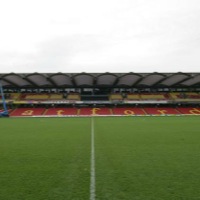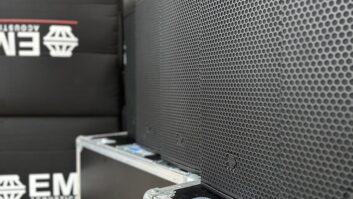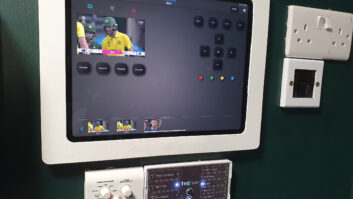
For fans of a football club, few sporting venues can match the excitement of your home ground, and Vicarage Road – home of Watford FC, nicknamed The Hornets – is no exception.
Of course, with thousands of fans attending week in, week out, it is important for venues like this to have an audio system that is suitable not only for announcements relating to games and team matters, but also one that complies with all relevant standards and legislation relating to mass-notification and voice alarm in sports venues.
However, in recent years the existing PA system at the 19,900-capacity Vicarage Road football ground was becoming unreliable and there was doubt as to whether it could perform as expected in the event of a public emergency. In compliance with the Green Guide and building regulations, an annual safety review of the audio system for life safety was carried out by Watford FC and Sennheiser UK. It was this review that established the need for an extensive upgrade.
It was necessary to supply a system that provides sufficient coverage for the ground, improving the audio performance in the bowl area (the pitch and stands) for sports presentation. However, the system also had to be flexible and powerful enough to supplement any non-sporting live events held in the ground, such as concerts by lifelong Watford fan Sir Elton John, to cite a recent example. Another stipulation was that the system needed to be installed during the football and rugby season (the ground is also home to Saracens Rugby Club) and around the venue’s many conferences and events.
Watford called in respected system designer Roland Hemming of RH Consulting, who worked with Sennheiser UK to specify a system that could cope with every eventuality.
Hemming’s solution comprises a combination of D.A.S. Audio Rf series loudspeakers for the bowl and D.A.S. Arco for the under balcony and bar areas, all of which were specifically modified for the project. A total of 162 Apart loudspeakers – 16 ceiling speakers and 146 sound projectors – were supplied for many of the back-of-house areas. Sennheiser’s ew500 G3 Series covers radio microphone requirements. In total, the system uses over 200 loudspeakers and is split into 20 zones.
The new bowl system covers three of the four stands, with the East Stand left unchanged and integrated into the new system. On-site installation took nine weeks, and was performed by E-Mech Entertainment Engineering (led by Huw Micklewright), with the existing PA/VA system remaining in place and connected to the new amplifiers and loudspeakers during the process, allowing 100% uptime of the PA/VA system during the transition from old to new.Because of the shape of the stands, and to get the throw to the back of the seating areas, the D.A.S. clusters were split into two hangs for the Vicarage Road and North Stand, while the Rouse Stand required double hangs. Rigging is predominantly D.A.S.’s own, although E-Mech has added some additional steels.
When it came to deciding how to control and power this extensive loudspeaker installation, Hemming opted for a familiar configuration that utilised the individual capability and compatibility elements of Peavey MediaMatrix NION n6 and PLM Series, Lab.gruppen’s flagship Powered Loudspeaker Management platform.
Designing the system around the MediaMatrix NIONs provided the benefit and security of being able to implement a networked dual redundant ring configuration – eliminating audio network downtime caused by a single point of failure. This was critical to the system’s fulfilment of dual roles as both standard PA (such as background music and commentary) and voice alarm (emergencies, evacuation messages). Among other notable benefits, the deployment of PLM Series meant the new system could be designed around Dante – viewed increasingly as the new de-facto low-latency digital audio network protocol – given that the PLM Series is fully capable on this front. Dual roles“We’re driving all of the circuits,” says Hemming. “A number of 100V line circuits for all the concourse and corridors; and high-power circuits into the bowl, with very high SPL levels to cover those areas. The reason we like Lab.gruppen PLM Series is that they can do both.
“We’re using the custom software that allows us to view, monitor and control the PLMs from within the NIONs, so it makes integration very easy. We have a nice touchscreen display that shows us all of the 20 zones, and Dante allows us to use one system for monitoring and control. There are no latency issues, no issues with bundles that you might have with Cobranet, and all in all, it’s a very simple network.”
There are two rack positions, one in the North and one in the South connected in a dual redundant fibre optic loop. Around 12km of fireproof cable connects to the loudspeakers.
“The PLMs have all of the processing built into them, so there’s a lot less programming involved in the set-up,” Hemming continues. “We’re using the NIONs very simply to provide inputs, routing and control, but all of the loudspeaker tuning is done by the PLMs, so it’s an ideal solution for the stadium.”
“The other reason for PLMs is that they distribute the processing, so if we do have any failures within the NIONs, the D.A.S. loudspeakers will still sound optimal. We’re using both two- and four-channel amps, and they are compact, so the entire thing fits into two racks. The initial cost may be slightly higher when compared with other amplifier platforms in the same power bracket; however, due to the PLM’s Universal Power Supply and the relatively low current draw, overall cost of ownership is significantly lower. In terms of total cost of installation and ownership, PLM Series is actually a very compelling amplifier to use for voice alarm applications.”
The new system is compliant with the latest British standards BS5839 part 8 and BS7827, a code of practice for designing, specifying, maintaining and operating emergency sound systems at sports venues. It is the first system to be signed off against the latest revision of BS7827, launched in September 2011.
Hemming concludes: “The entire system has provided a significant improvement on what was there previously. It’s a nice stadium system that is both adaptable in terms of usability and also very cost effective. The combination of the MediaMatrix NIONs integrating with the Lab.gruppen amplifiers via Dante works very well, and the clarity and definition of the D.A.S. loudspeakers gives us an exemplary system. In many ways, such as pounds per decibel, this whole system is amazingly good value.” www.apart-audio.comwww.dasaudio.com www.eade.uk.comwww.labgruppen.comwww.mm.peavey.comwww.rhconsulting.comwww.sennheiser.co.uk







